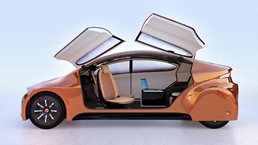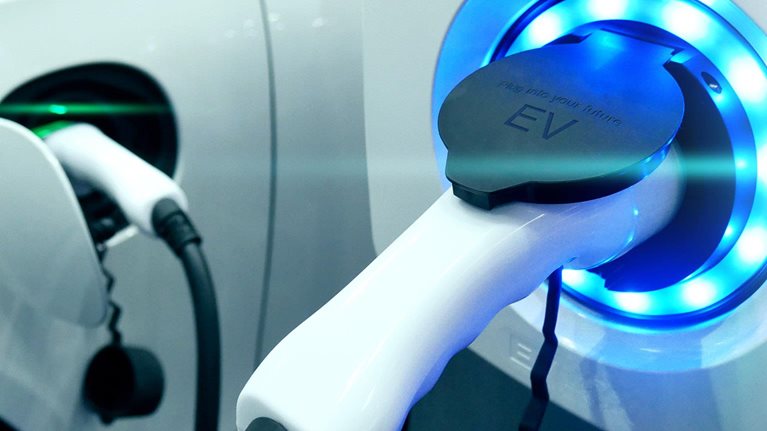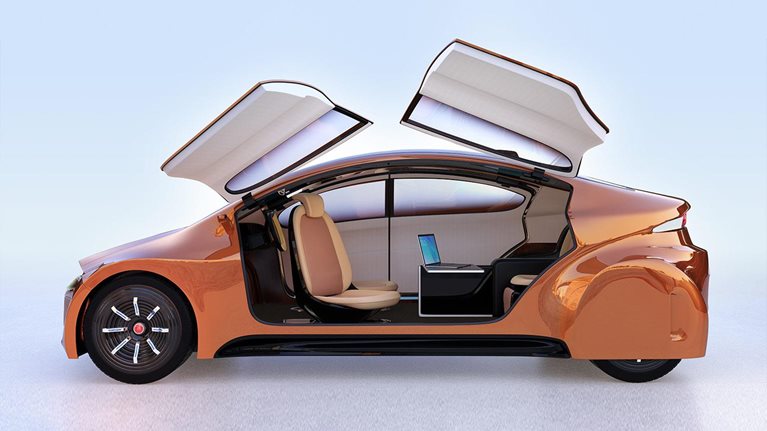We believe 2018 could represent a distinct tipping point from thinking, talking about, and planning for future mobility to implementing it. It’s the year when a firework of electric-vehicle (EV) launches began and charging infrastructure became solid in key regions; when cars enabled by artificial intelligence (AI) began to replace “dumb” ones; when we moved from advanced driver-assistance systems to autonomous vehicles (AVs) in real life; when the automotive and mobility industries shifted from a driver- or owner-focused value proposition to a customer-centered one; and when micromobility started to scale up.
Stay current on your favorite topics
You can make the case that all four ACES trends—autonomous driving, connected cars, electrification, and smart mobility—made appreciable advances in 2018, despite some setbacks. It was the year when theoretical discussions about the future of mobility turned into concrete actions across businesses, cities, and key world regions. Please join us in reviewing some of the highlights from this singular year and exploring what the future could bring.
Autonomous vehicles
Possibly the furthest into the future measured by large-scale commercialization, AVs still appear on track in terms of technology. While manufacturers are still working to ensure safety requirements are met, they seem to have overcome major technology hurdles, and most of them made exciting moves in 2018. OEMs are seriously considering AVs as a business. They reallocate capacity and their vehicle portfolio to free up cash for AV investments, restructure their organizations by moving key executives to AV business units, and are most aggressive in forming partnerships with cities and local municipalities.
High cost is an ongoing concern, however, which is one reason major automotive, high-tech, and mobility players are teaming up (Exhibit 1). The field is becoming more crowded as well—for example, with all three of China’s big tech players now pursuing AVs.

The pace of overall investment in future mobility technology is accelerating greatly: between the periods of 2010 to 2013 and 2014 to 2017, the average annual investment across all technologies jumped nearly sixfold, to $25.3 billion per year, from $4.3 billion per year. While investments in sharing and autonomous solutions account for much of this acceleration, investments in hardware like sensors and semiconductors are rather stable, showing a steady trend of consolidation. (For a deeper dive on the topic, see “Analyzing start-up and investment trends in the mobility ecosystem.”)
Overall, regulation remains supportive of AVs. In 2018, many regions adopted new definitions that pave the way for vehicles without steering wheels. We have also noted that industry players are engaging in self-regulation when AV crashes occur by voluntarily suspending testing activities. Such responsibility apparently does not go unnoticed by consumers: in McKinsey’s recent ACES survey, 42 percent of respondents had a positive view of the technology.
Mobility and automotive players increasingly focus on use cases to understand the imminent AV market, as growing numbers of them concentrate on bringing viable products to market as soon as possible. Early target cities include Phoenix and San Francisco, and we are hearing much more about so-called “geofenced” applications for use in airports and other similarly enclosed venues. Companies are also working out the bugs on specific AV applications, such as those enabling AV fleets to relocate autonomous carsharing vehicles at night in places like Eindhoven in the Netherlands. It has become clear that different players explore different use cases—from robo-taxis, autonomous shuttles, to private-campus autonomous shuttles—which indicates that this market offers room for multiple players to exist.
It becomes clearer that most AV companies plan to operate the fleet without major infrastructure measures.
As the automotive industry transitions from hardware- to software-defined vehicles, the average software and electronics content per vehicle is rapidly increasing (Exhibit 2). And AI will continue to play an important role (Exhibit 3).

Software represents 10 percent of overall vehicle content today for a D-segment, or large, car (approximately $1,220), and the average share of software is expected to grow at a compound annual rate of 11 percent, to reach 30 percent of overall vehicle content (around $5,200) in 2030. Not surprisingly, players across the digital automotive value chain are attempting to capitalize on innovations enabled through software and electronics. (For more, see “Rethinking car software and electronics architecture.”)

AI is creating value not only in the vehicle itself but also in the company: in the short to medium term, there is a substantial, AI-enabled opportunity that by 2025 could reach an annual value of about $215 billion for automotive OEMs worldwide (Exhibit 3). This corresponds to nine percentage points of earnings before interest and taxes for the whole automotive industry, or a theoretical average-annual-productivity increase of approximately 1.3 percent over seven years—a significant value to boost the industry’s regular productivity aspiration of about 2 percent annually. (For more, see “Artificial intelligence as auto companies’ new engine of value.”)
Connected cars
This is another trend in which the industry focus is shifting from discussing to doing. Monetizing all that car data is a hot topic in this area, with more companies exploring the prospects for in-car payments. McKinsey’s ACES survey suggests that consumers expect to spend nearly 30 percent of their time in an AV focused on entertainment offers and online shopping.
Industry stakeholders (and governments) increasingly seek to “stack hands” on standards while also finding new ways of cooperating and sharing data streams and cybersecurity (Exhibit 4). In one case, two ridesharing companies have joined forces to share data with cities.

Although most recognize that today’s and tomorrow’s car will increasingly be connected, there is no clear-cut standard yet to define what “connectivity” means. This lack of clarity is hindering the development of connectivity use cases, as there is no standard language for industry, and it is difficult for customers to compare features and understand how the capability of the cars matches their needs. To address the issue, McKinsey developed a Connected Car Customer Experience (C3X) framework (Exhibit 4). The C3X framework describes five levels of user experience in connected cars—ranging from the most basic to the highly complex. (For more, see “Setting the framework for car connectivity and user experience.”)
Would you like to learn more about the McKinsey Center for Future Mobility?
Connected-car advances are forcing traditional automotive companies to rethink car software and electronics architecture, and several have launched AI-supported human–machine interfaces with a totally different level of user experience and truly modular infotainment platforms, enabling also over-the-air updates at scale. Some players keep pushing the boundaries of software and computing power, with one EV company installing the most advanced centralization of computing power in a water-cooled supercomputer. Another key challenge involves efforts to integrate future fifth-generation telecom technologies into connected-car platforms.
Electric vehicles
Regulation remains the primary market maker for EVs, offering substantial incentives as well as noncash benefits, such as special-highway-lane access and favorable licensing arrangements. This strong regulatory “push” helps to make the EV tipping point the most visible among the four ACES trends (Exhibit 5). More countries and cities are announcing plans to ban the internal combustion engine, and while the European Union has proposed ambitious passenger-car and truck carbon-dioxide (CO2) reductions through 2030 this year, the United States is the only major government focused on unwinding its aspirational CO2 targets.

Electric mobility follows the same four-step evolution as other disruptive trends do. Having reached a critical mass of EVs, Norway is clearly ahead of other countries—the EV disruption is inevitable. Most other countries are still in the first stage, except for China and Sweden, which have already advanced to the second: disruption is somewhat more clear, with the EV emerging as a validated model. (For more, see “The global electric-vehicle market is amped up and on the rise.”)
From a technology perspective, the EV industry has moved from a wait-and-see mode to one focused on doing—building plants, forging alliances, and making acquisitions. Batteries and the raw materials to produce them remain a key EV challenge (Exhibit 6), and a wide variety of companies around the world are establishing production capacity. They are also hammering out details regarding greater technological cooperation via joint ventures and other types of alliances with governments (as seen with charging infrastructure) and new mobility-industry players, such as tech giants, chip makers, and battery producers (Exhibit 7).

Despite higher up-front investments—in the form of engineering hours, new tooling, and so on—native EV platforms have proved advantageous over nonnative models in multiple ways. Designing the vehicle architecture entirely around an EV concept, without combustion-engine-legacy elements, means fewer compromises and more flexibility, on average. (For more, see “What a teardown of the latest electric vehicles reveals about the future of mass-market EVs.”)

Based on charging profiles and available technologies, the industry could require approximately 40 million chargers across China, Europe, and the United States, representing an estimated $50 billion of cumulative capital investment through 2030. (For more, see “Charging ahead: Electric-vehicle infrastructure demand.”)
Several new EV OEMs opened for business in 2018 (there are now more than 60 EV brands in China alone), and more are slated to begin production in 2019. Focused primarily on passenger vehicles, a variety of players will also concentrate on commercial vehicles. Traditional OEMs are introducing an increasingly rich and attractive array of EV models, including cars, SUVs, buses, and medium- and heavy-duty trucks. From a regional perspective, China remains the EV-market leader, with companies there gaining a 46 percent production-market share.

How the auto industry is preparing for the car of the future
While EVs remain one of the most visible ACES trends, it became more and more clear this year that we need a broad power-train portfolio that will last for a long time. For example, hydrogen has gained increasing currency as one of the key ways to make the transition to clean energy happen. Look for more on hydrogen over the next 12 months.
Smart or shared mobility
The “next big thing” in shared mobility could be rather small: micromobility. It involves the use of shared electric scooters, bicycles, and other simple conveyances, facilitated via special apps. The industry has already attracted more than $1 billion in investments. However, as bikesharing services in China show, successful micromobility plays require robust organization and strong community and local government support.
In general, shared mobility offers cities an outsize opportunity to solve some critical problems, but left unmanaged, it could create some equally large challenges. Meanwhile, several major automakers are pushing to take active shared-mobility roles and restructuring their current mobility organizations to create entirely new business models, sometimes in league with major competitors. Other OEMs are pushing new mobility-subscription models as well.
The ride-hailing market continued to evolve in 2018, with major players focusing on fewer markets with greater market shares. The overall lack of profitability of carsharing and ride-hailing businesses remains a central industry challenge—one that will become a more visible issue as major players prepare to launch initial public offerings.
A parallel industry development involves freightsharing or trucksharing, especially when dealing with “last mile” deliveries (Exhibit 8).

Customers are demanding more from their delivery providers, and a highly competitive environment combined with customer sensitivity to high cost has pushed forward the development of technology that will help the industry deliver on these demands. Combined, these trends mandate immediate adoption of these new technologies by last-mile players. The growing importance of technology in the last-mile industry will affect the overall ecosystem, including its competitive dynamics and the distribution of value across industry players. (For more, see “Technology delivered: Implications for cost, customers, and competition in the last-mile ecosystem.”)
It has also been an exciting year for urban aerial mobility, personal air vehicles, electric vertical takeoff and landing, or, more informally, “flying cars”—whichever term you prefer to describe new vehicles transporting people through the air in cities and their surroundings. On the investment side, we have seen the first triple-digit investment round. Fueled by the increased funding and awareness, there are now more than 100 companies exploring different designs and operational models. At the same time, we are seeing pioneers in this field move toward operational testing, with one player announcing flight tests in the center of Singapore in the second half of 2019. All these advances are pushing regulators to move at speeds unheard of before. Creating a safe and reliable new mode of transportation in the urban environment will continue to push all players to their limits.
All eyes on 2019
As the next 12 months unfold, and the pace of change in the mobility sector likely quickens, we would like to raise several key questions regarding the future of mobility as a whole and of the four ACES trends in particular. First, the general question: Will cities build integrated seamless mobility plans and, in the process, orchestrate ecosystems and drive the four ACES trends to completion as elements of their own visions of smart cities?
For AVs, how will the experiences of the first real-life applications influence the subsequent industry, and should mobility players focus on managing the public debate on the levels of technology failure users will accept? Likewise, will we see a convergence of driving systems, and will clear “winners” emerge in the tech stack?
As for connected cars, will increasing connectivity enable breakthroughs in certain use cases, such as predictive maintenance? Will players create business models around connectivity that create new levels of value for consumers?
Regarding electrification, how will the availability of many more EVs play out? Will it seem like a general market ramp-up, or will market shares of established OEMs versus new players change the retail market in fundamental ways? What will happen to industry profitability?
Regarding smart and shared mobility, will use cases emerge that can scale up shared mobility in areas like commuting? Will established platform providers become the winners behind mobility as a service and new mobility platforms? And finally, what will it take to establish a successful micromobility business? As the future of mobility begins to unfold, companies, regulators, and society alike will need to keep both eyes on the street in 2019 to manage the technological disruptions.
Download “Reserve a seat—the future of mobility is arriving early,” to read the full collection of articles discussed (PDF–6MB).


